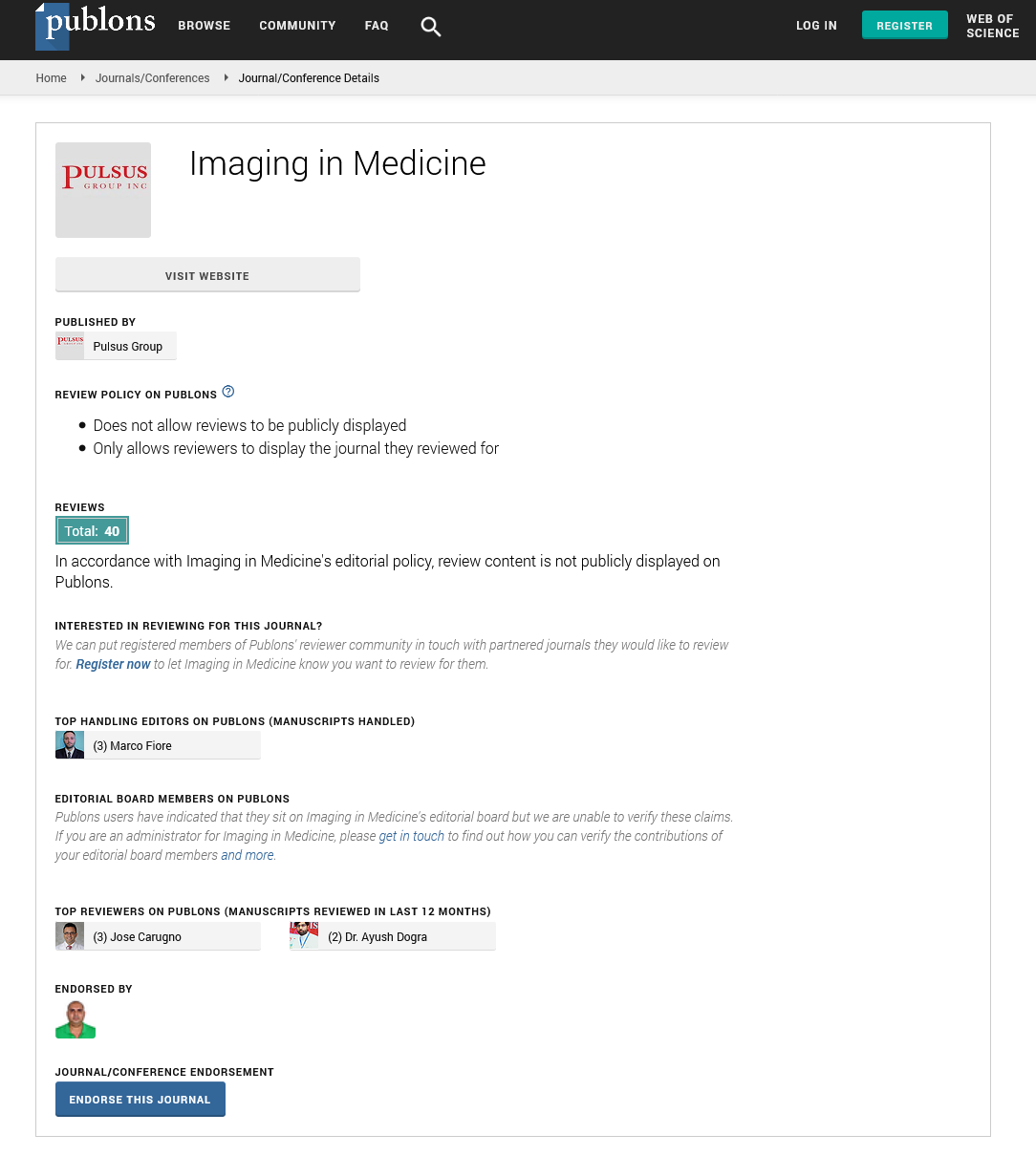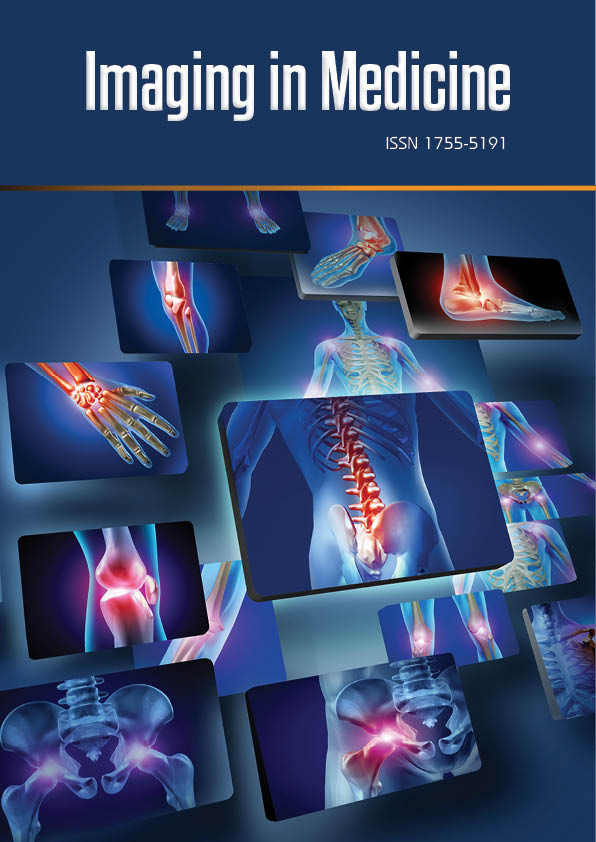Editorial - Imaging in Medicine (2025) Volume 17, Issue 1
Portable Imaging Devices: Bringing Diagnostics to the Patient
Saez Armenta*
Department of Analytical Chemistry, University of Valencia, Burjassot, Valencia, Spain
- *Corresponding Author:
- Saez Armenta
Department of Analytical Chemistry, University of Valencia, Burjassot, Valencia, Spain
E-mail: saez.armenta@gmail.com
Received: 17-Jan-2024, Manuscript No. fmim- 25-169969; Editor assigned: 20-Jan-2024, PreQC No. fmim-25-169969 (PQ); Reviewed: 04-October-2024, QC No. fmim-25-169969; Revised: 14-Jan-2024, Manuscript No. fmim- 25-169969 (R); Published: 21-Jan-2024, DOI: 10.47532/1755-5191.2025.17(1).1-3
Introduction
Portable imaging devices represent one of the most exciting advancements in modern medical technology. Unlike traditional imaging equipment that is bulky, expensive, and restricted to hospital radiology departments, portable devices allow imaging to be performed directly at the patient’s bedside, in remote clinics, or even in disaster zones [1]. These devices—including portable X-rays, handheld ultrasounds, and compact CT scanners—are transforming the way healthcare providers diagnose and monitor patients by making imaging faster, more accessible, and more cost-effective.
What Are Portable Imaging Devices?
Portable imaging devices are compact, lightweight versions of conventional imaging machines. They rely on advancements in miniaturization, wireless technology, and battery efficiency to perform essential diagnostic functions outside of traditional radiology suites. Many are designed to connect to tablets or smartphones, allowing images to be viewed, stored, and transmitted instantly. By reducing dependence on large infrastructure, these devices make medical imaging more flexible and adaptable to different healthcare settings [2].
Types of Portable Imaging Devices
Several types of portable imaging technologies are already widely used:
Portable X-ray Machines: Used in emergency departments, operating rooms, and at patients’ bedsides, these allow clinicians to quickly assess fractures, chest infections, or line placements without moving the patient.
Handheld Ultrasound Devices: Small probes that connect to a smartphone or tablet, enabling clinicians to visualize internal organs, monitor pregnancies, or assess heart function in real time.
Portable CT Scanners: Compact CT systems are increasingly used in intensive care units or stroke centers, where immediate brain imaging can guide urgent treatment.
Portable MRI Devices: Although still in early stages, low-field portable MRI machines are being introduced for brain imaging, offering safer and faster diagnosis in critical situations [3].
Applications in Healthcare
Portable imaging devices have a wide range of applications:
Emergency and Critical Care: Bedside imaging eliminates the need to transport unstable patients to radiology departments.
Rural and Remote Medicine: Portable devices bring advanced diagnostics to areas with limited infrastructure.
Disaster and Military Medicine: In field hospitals or disaster zones, portable imaging aids in rapid diagnosis of injuries.
Primary Care: Handheld ultrasounds are increasingly used in clinics for quick assessments, enhancing physical exams [4].
Home Healthcare: Emerging models of portable devices may eventually allow imaging in home-based care, particularly for patients with mobility challenges.
Advantages of Portable Imaging Devices
The adoption of portable imaging is driven by its many benefits:
Accessibility: Extends diagnostic capabilities to underserved populations and remote locations.
Speed: Provides rapid imaging, essential for emergency care and critical decision-making.
Cost-Effectiveness: Smaller devices often cost less than traditional machines, reducing healthcare expenses.
Patient Safety: Eliminates the risks associated with moving critically ill or injured patients.
Connectivity: Digital storage and wireless transmission allow instant sharing with specialists, enhancing collaboration.
Limitations and Challenges
Despite their promise, portable imaging devices face several challenges:
Image Quality: While improving, portable devices may not yet match the resolution of full-sized machines.
Training Needs: Effective use requires proper training; unskilled operation may lead to misdiagnosis [5].
Battery and Durability Issues: Devices used in the field must be reliable, with sufficient battery life and rugged design.
Cost Barriers in Low-Resource Settings: Although less expensive than conventional machines, devices may still be costly for some regions.
Regulatory and Data Security Concerns: Ensuring devices meet safety standards and protect patient data remains critical.
The Future of Portable Imaging
Advances in artificial intelligence (AI), cloud integration, and wireless technology are shaping the future of portable imaging. AI-powered handheld ultrasounds can assist in interpreting images, helping non-specialists perform accurate scans. Portable MRI and CT devices are becoming more compact, offering higher-quality imaging with lower radiation exposure. As technology matures, portable imaging may become standard in telemedicine, home healthcare, and even routine checkups, fundamentally changing how and where diagnostic imaging is performed.
Conclusion
Portable imaging devices are revolutionizing medical diagnostics by bringing advanced imaging directly to patients, wherever they are. From emergency rooms to rural clinics and disaster sites, these devices improve access, speed, and patient safety while reducing healthcare costs. Though challenges remain in terms of image quality, cost, and training, ongoing innovations promise to expand their capabilities and reliability. As technology continues to advance, portable imaging devices will play a crucial role in making healthcare more patient-centered, accessible, and efficient.
References
- Huang J, Chen P, Liu K, Liu J, Zhou B, et al. (2021) CDK1/2/5 inhibition overcomes IFNG-mediated adaptive immune resistance in pancreatic cancer. Gut 70: 890-899.
- Liu R, Fan M, Candas D, Qin L, Zhang X, et al. (2015) CDK1-Mediated SIRT3 Activation Enhances Mitochondrial Function and Tumor Radioresistance. Mol Cancer Ther 14: 2090-2102.
- Tang Q, Li W, Zheng X, Ren L, Liu J, et al. (2020) MELK is an oncogenic kinase essential for metastasis, mitotic progression, and programmed death in lung carcinoma. Signal Transduct Target Ther 5: 279.
- Zhao S, Wang B, Ma Y, Kuang J, Liang J, et al. (2020) NUCKS1 Promotes Proliferation, Invasion and Migration of Non-Small Cell Lung Cancer by Upregulating CDK1 Expression. Cancer Manag Res 12: 13311-13323.
- Liu S, Yang Y, Jiang S, Xu H, Tang N, et al. (2019) MiR-378a-5p Regulates Proliferation and Migration in Vascular Smooth Muscle Cell by Targeting CDK1. Front Genet 10: 22.
Google Scholar, Crossref, Indexed at
Google Scholar, Crossref, Indexed at
Google Scholar, Crossref, Indexed at
Google Scholar, Crossref, Indexed at


